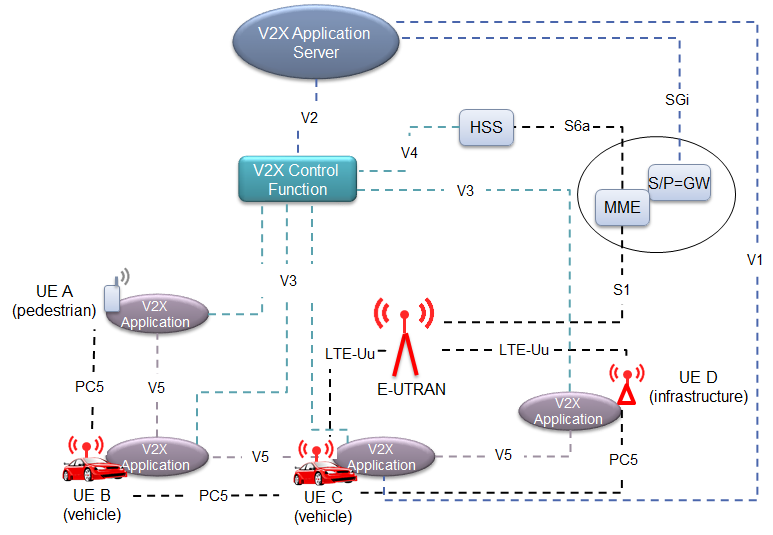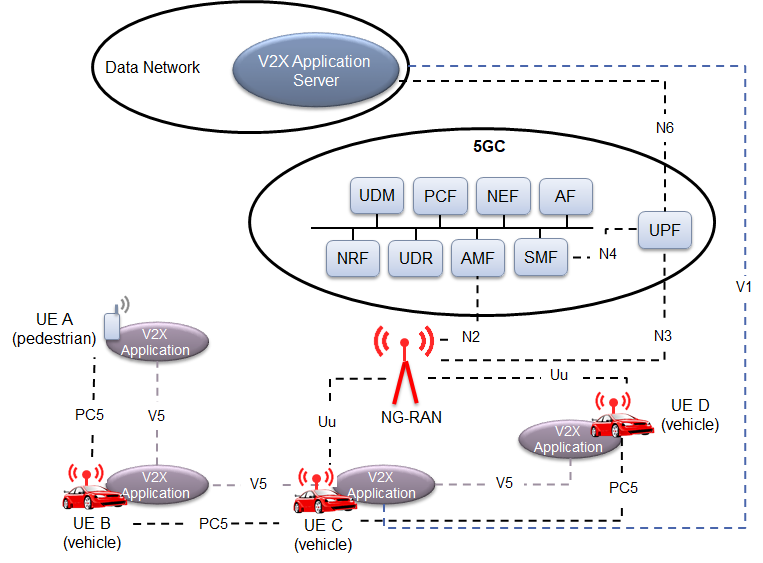V2X within the 3GPP standards – Overview, Requirements and Architecture
Introduction
As the aim of the 5G system is to provide ubiquitous connectivity, communications in transportation are an important part of it, formulating one of the so-called verticals. In this post, we will present the main features of the 3GPP Cellular Vehicle-to-Anything (C-V2X) standards, that comprise the Release 14/15 LTE-V2X and its successor – NR-V2X. Both utilize the so-called PC5 interface, also known as sidelink, for direct V2V (Vehicle-to-Vehicle) or V2P (Vehicle-to-Pedestrian) transmissions, with the Uu interface used for V2N (Vehicle-to-Network) connectivity.
Overview of V2X Communications
V2X communications are an essential element facilitating the operation of the Cooperative-Intelligent Transportation Systems (C-ITS) aiming at increasing road traffic safety and efficiency. The envisioned applications of V2X, such as cooperative awareness, road hazard warning, forward or intersection collision warning, electronic emergency brake lights, high-definition maps, route guidance, and navigation or electronic commerce, require a very versatile and reliable approach to vehicular communications.
Different communication links are possible within the V2X network, with direct V2V, V2P, Vehicle-to-Infrastructure (V2I), or V2N configurations defined. Therefore, the employed wireless communication standard must fulfill the diverse requirements in a very challenging, fast-varying environment.
The introduction of Dedicated Short-Range Communications (DSRC) at the beginning of the millennium started the rapid development of V2X communication standards. The DSRC, or its European equivalent ITS-G5, is the first V2X technology introduced, that relies on the IEEE 802.11p standard. Since its introduction, it has been shown that V2X communications using IEEE 802.11p have severe limitations mostly in terms of range, handling of high mobility, and efficiency in the use of radio resources. Due to the use of convolutional coding, no HARQ mechanisms, and specific reference signals design, the typical range of IEEE 802.11p-based vehicular communications is limited to no more than 300 m.
Furthermore, the multiple access method relying on CSMA-CA (Carrier Sense Multiple Access-Collision Avoidance) contention-based access and the asynchronous character of IEEE 802.11p results in poor utilization of available resources and may lead to channel congestion when high traffic density is experienced. The limitations of DSRC/ITS-G5 led to the development of a new V2X communication standard, known as C-V2X, being a part of the 3GPP LTE and its successor – 3GPP NR. With a stronger coding scheme, the possibility to use soft combining with HARQ, and network synchronization allowing for multiple access with division in the time and frequency domain, the new standard offers higher efficiency, flexibility, and robustness.
Frequency band challenges
The direct V2V communications are expected to operate in the 5.9 GHz intelligent transportation systems (ITS) frequency band, according to the spectrum regulations approved by both the European Commission and the Federal Communications Commission (FCC) in the US. These comprise 7 channels, each of 10 MHz bandwidth. However, this spectrum is designated on a technology-neutral basis, meaning that different technologies can be used there, including C-V2X or DSRC/ITS-G5. Thus, the use of spectrum certainly needs to be aligned on a technology basis to facilitate the coexistence of both solutions. Furthermore, the regulations permit at most 10 MHz channelization, which does not allow for 20 MHz or wider bandwidth specified for the NR-V2X [1].
The V2I or V2N communications using the Uu interface use selected licensed 3GPP LTE or NR uplink or downlink bands.
Requirements
Four challenging use cases have been defined by 3GPP:
- Vehicle platooning,
- Advanced driving,
- Extended sensors,
- Remote driving.
These four usages encompass many different applications with diverse requirements for sidelink communications [2], depending on different applications, which are summarized in the following table.
| Use case | Payload [bytes] | Tx rate [message/s] | Data rate [Mbps] | Max. latency [ms] | Reliability | Min. range [m] |
| Platooning | 50-6000 | 2-50 | up to 65 | 10-25 | 90-99.99% | 80-350 |
| Advanced driving | 300-12000 | 10-100 | 10-50 | 3-100 | 90-99.999% | 360-700 |
| Extended sensors | 1600 | 10 | 10-1000 | 3-100 | 90-99.999% | 50-1000 |
Table I Sidelink requirements for the use cases of V2X defined by 3GPP [2]
Architecture modifications for V2X
An important network element introduced with V2X communications is the infrastructure – the RoadSide Unit (RSU). In LTE or NR it can be either a fixed-location UE capable of V2X communications or an eNodeB/gNodeB.
Moreover, Release 14 of the 3GPP LTE standard introduced several additional network architecture entities supporting V2X communications. These include:
- V2X Control Function that provides the configuration parameters for the vehicular UEs. The configuration is specified for both in-coverage and out-of-coverage UEs.
- V2X Application Server that is responsible for most of the network functionalities realted to V2X, including: reception of uplink V2N messages, distribution of unicast or multicast data to the vehicular UEs and mapping of the UEs’ geographic locations into the Service Area Identifiers (SAI) of MBMS.
- V2X Application located on board of each vehicular UE or RSU that communicates with the V2X Application Server.
Apart from the mentioned new entities, the Mobility Management Entity (MME) functionality has been extended with the mechanisms for UE authorization and collecting the subscription information for V2X services.

The NR-V2X introduces new system architecture aiming at the use of Network Function Virtualization, where the control plane is constituted with specific network functions (NF). With the focus on V2X the following modifications are introduced:
- There is no V2X Control Function. The UE may receive the parameters for V2X communications from: the Policy Control Function (PCF), the V2X Application Server or these can be pre-configured. These V2X parameters provided by PCF also to Access and Mobility Management Function (AMF) are used in configuration and management of V2X communications.
- V2X parameters are stored in Unified Data Repository (UDR)
- Network Repository Function (NRF) helps other NF to discover and select apropriate PCF accounting for V2X capability.
- Network Exposure Function (NEF) services facilitate communication between NFs and the V2X Application Server.
- The V2X Application Server and V2X Application include Application Function.
No new interfaces at the architecture level are required for simultaneous operation of the LTE-V2X and NR-V2X. The parameters for LTE-V2X can be then provided by the V2X Control Function or the PCF, while the parameters for NR-V2X are provided only by PCF [3].

Summary
The architectural design and the interfaces specified within the C-V2X standards certainly show the great potential of these technologies. While LTE-V2X suffers from compatibility need with the LTE standard, including e.g. fixed numerology, the NR-V2X is a very versatile and sophisticated technology capable of fulfilling the requirements for V2X communications. However, it requires additional regulatory work to adapt the spectrum specified for direct V2X communications using sidelink to the needs of NR-V2X. Furthermore, as DSRC/ITS-G5 has been already deployed in many areas or vehicles, coexistence issues between the two standard groups need to be considered.
For more details on specific aspects of V2X, like the PHY layer or QoS, see my next post: C-V2X Phy Layer, Resource Allocation, Synchronization, and QoS.
References
[1] 5GAA Automotive Association, „Deployment band configuration for C-V2X at 5.9 GHz in Europe”, 2021, [online, available at: 5GAA_S-210019_Position-paper-on-European-deployment-band-configuration-for-C-V2X_final.pdf]
[2] 3GPP TS 22.186 Service requirements for enhanced V2X scenarios (v16.2.0, Release 16),” 3GPP, Tech. Spec., Jun. 2019.
[3] M. H. C. Garcia et al., „A Tutorial on 5G NR V2X Communications,” in IEEE Communications Surveys & Tutorials, vol. 23, no. 3, pp. 1972-2026, 2021.
[4] V2X (3gpp.org)
Related blog posts
- V2X details PHY, QoS, synchronization and RRM: C-V2X Phy Layer, Resource Allocation, Synchronization, and QoS
- Preliminary discussion on 3GPP Rel-18: 3GPP Rel-18: The Preliminary Discussions
- 3GPP Rel-17 overview: 3GPP Rel-17: Way forward within 5G standardization
Author Bio
Paweł Sroka is an assistant professor at Poznan University of Technology’s Institute of Radiocommunications (www.ir.put.poznan.pl/u/sroka), Poland. His research interests include multiple access methods, radio resource management, and interference management for wireless systems, MIMO systems, and vehicular communications. Paweł received his Ph.D. in telecommunications in December 2012 at Poznan University of Technology. He took part in numerous international research projects: WINNER II, WINNER+, NEWCOM ++, and METIS, as well as industrial and national projects. At Rimedo Labs, Pawel serves as Senior Consultant and Project Manager.
